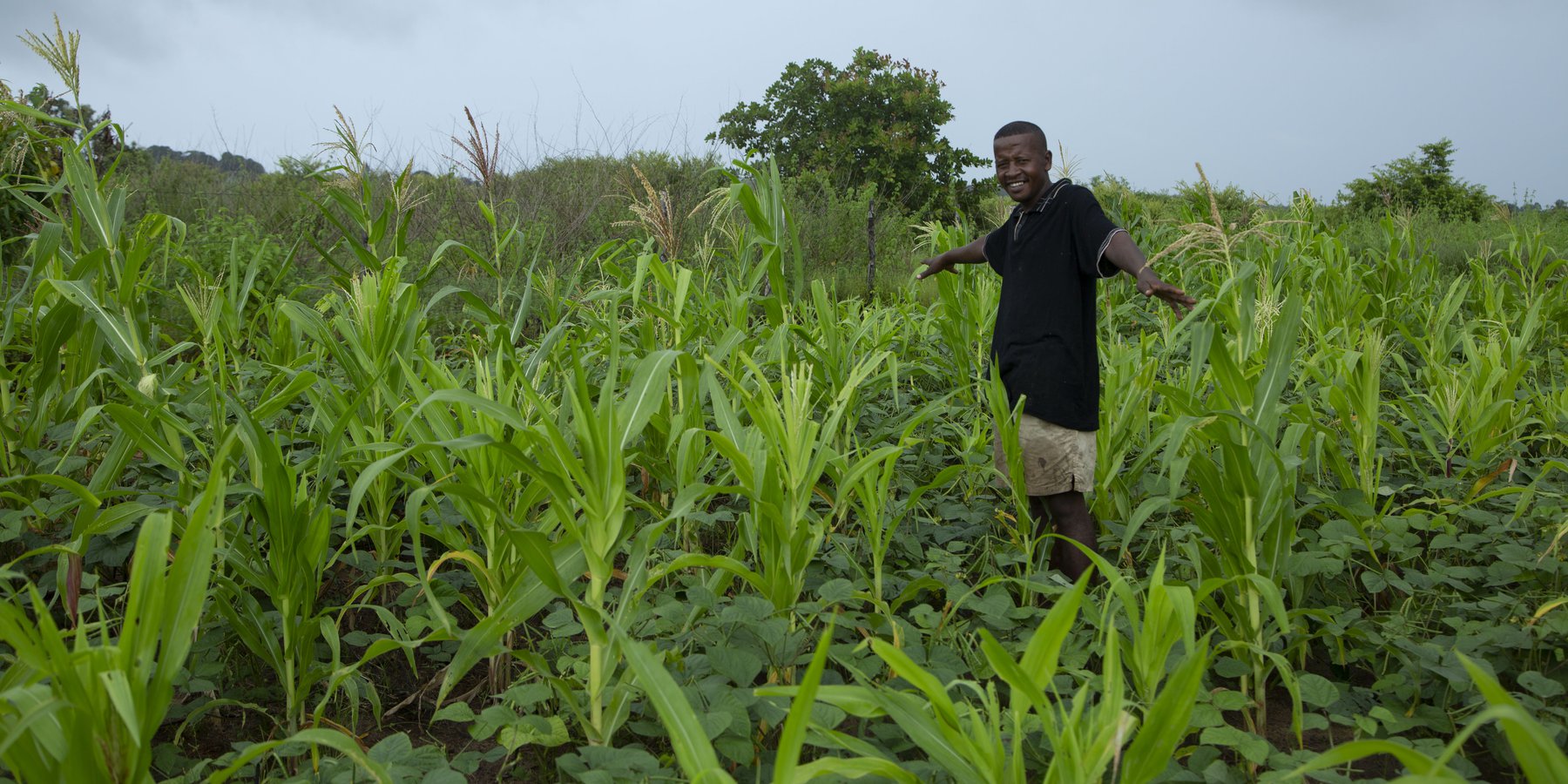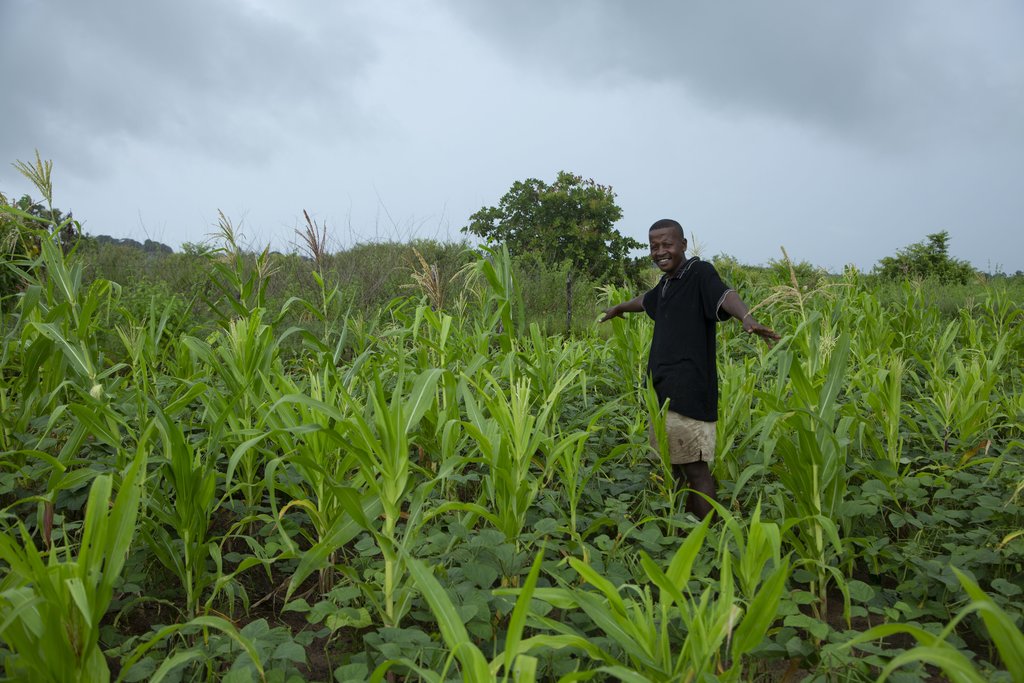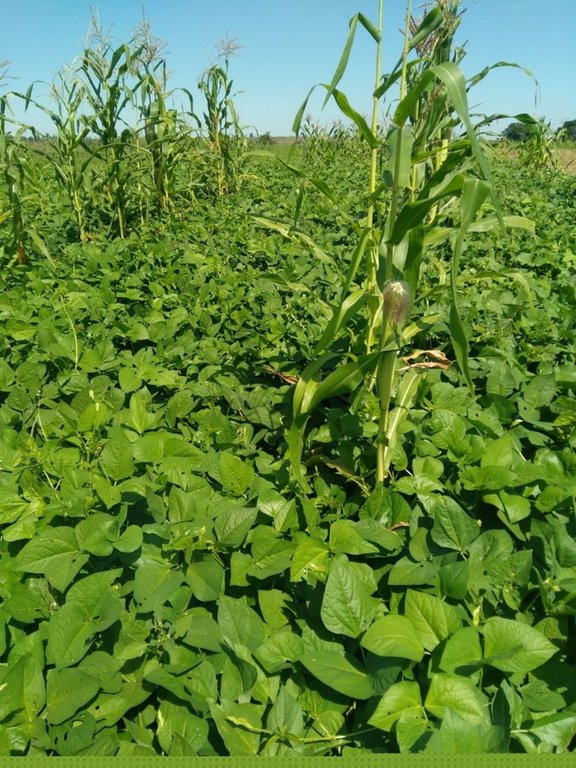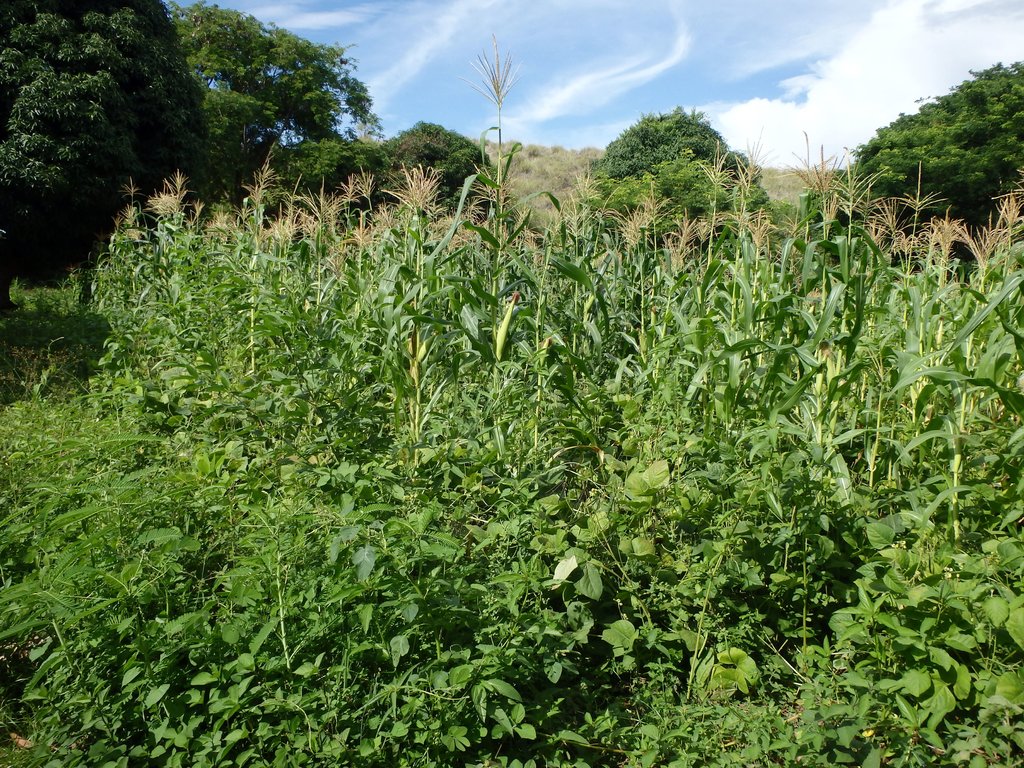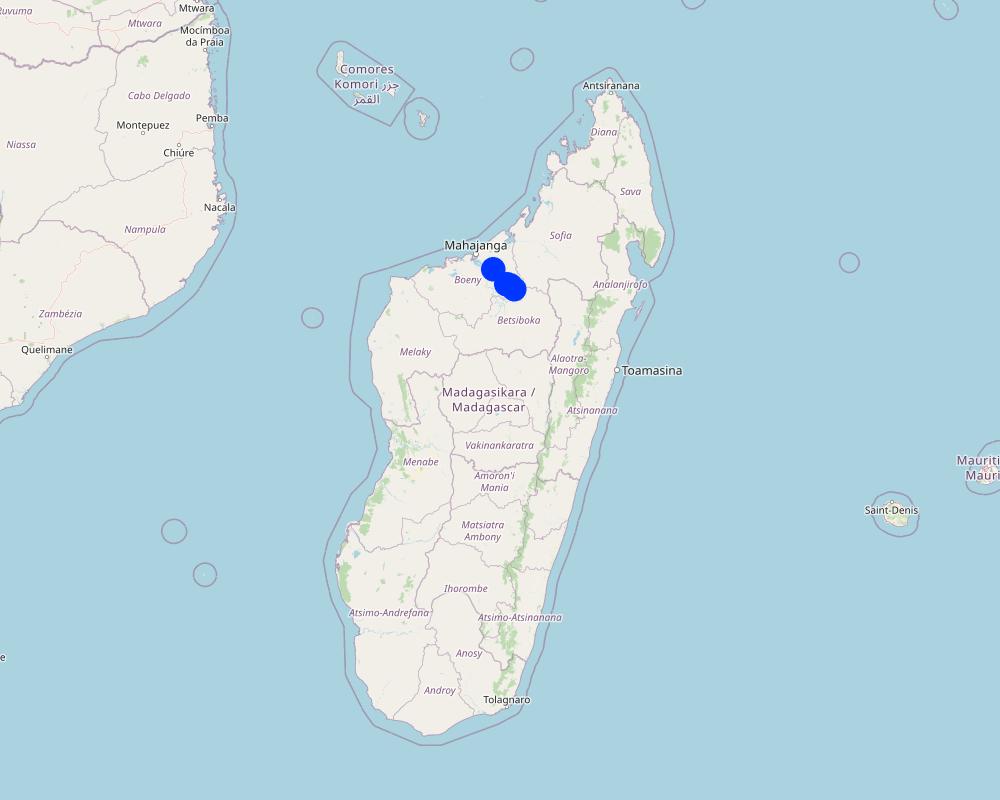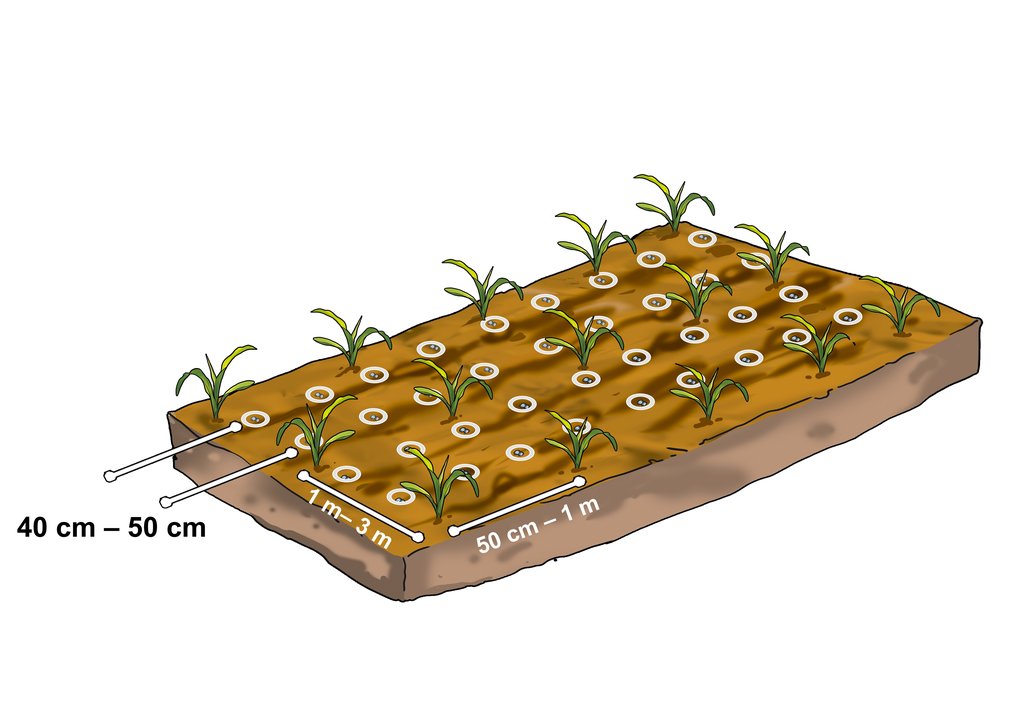Intercropping of Maize and Cowpeas [Madagascar]
- Creation:
- Update:
- Compiler: Harifidy RAKOTO RATSIMBA
- Editors: Felana Nantenaina RAMALASON, Dimby RAHERINJATOVOARISON, Siagbé Golli, Tahiry Ravivonandrasana, Natacha Rabeary, Tabitha Nekesa, Ahmadou Gaye
- Reviewers: William Critchley, Rima Mekdaschi Studer
Fampivadiana Katsaka sy Lojy, Katsaka sy Lojy, Fampivadiana voly
technologies_6474 - Madagascar
View sections
Expand all Collapse all1. General information
1.2 Contact details of resource persons and institutions involved in the assessment and documentation of the Technology
Key resource person(s)
land user:
SOAZY
Madagascar
land user:
MAKA
Madagascar
land user:
FARANTSA
Madagascar
land user:
ANGELINE
Madagascar
land user:
RAKOTOARIVELO Heriniaina Joseph
Madagascar
Name of project which facilitated the documentation/ evaluation of the Technology (if relevant)
Soil protection and rehabilitation for food security (ProSo(i)l)Name of the institution(s) which facilitated the documentation/ evaluation of the Technology (if relevant)
Deutsche Gesellschaft für Internationale Zusammenarbeit (GIZ)1.3 Conditions regarding the use of data documented through WOCAT
The compiler and key resource person(s) accept the conditions regarding the use of data documented through WOCAT:
Yes
1.4 Declaration on sustainability of the described Technology
Is the Technology described here problematic with regard to land degradation, so that it cannot be declared a sustainable land management technology?
No
2. Description of the SLM Technology
2.1 Short description of the Technology
Definition of the Technology:
Intercropping maize with legumes improves soil fertility and provides a rapid source of income for smallholders. Red cowpea, known locally as “lojy zazamena”, is the most widely used legume, but there are also other varieties of cowpea (Vigna unguiculata) that adapt well to the region's environmental conditions.
2.2 Detailed description of the Technology
Description:
Intercropping maize (Zea mays) with legumes improves soil fertility and provides a rapid source of income for smallholders. Red cowpea, known locally as "lojy zazamena", is the most widely used legume, but there are also other varieties of cowpea (Vigna unguiculata) that adapt well to the region's environmental conditions (i.e. Baboka, Rapaenta). This type of crop association is practiced on all types of soil, both on slopes and on the flatter lowlands. It is applied by all categories of farmers (small, medium and large-scale). Typically, maize is sown in rows with 1 m between rows and 50 cm between plants (1 m on less fertile soils). Legumes, on the other hand, are sown between rows of maize, with 50 cm between plants. However many farmers leave spaces of 2 m or more between rows of maize to make it easier to spray legumes. In this case, 2 rows of legumes can be intercropped between the maize rows to facilitate spraying. Maize and legume seeds are concurrently sown, usually at the end of December. The cowpea production cycle spans 3 months, with staggered harvesting if needed. In the event of low rainfall during the cycle, cowpeas can survive even if the maize is not sufficiently productive. The combination of maize and legumes maintains soil fertility of the plot where it is applied – better than a similar plot of monoculture maize, or maize combined with non-leguminous plants. This technique curbs erosion and minimizes weed proliferation, while contributing to household food security by enabling the cultivation of two different crops on the same plot. Having several species on the same plot reduces risks, especially the likelihood of crop pest infestation. This integrated crop approach is frequently embraced by households in need of rapid income, especially during the lean seasons, and helps secure subsistence. This technique is much appreciated by farmers.
2.3 Photos of the Technology
2.5 Country/ region/ locations where the Technology has been applied and which are covered by this assessment
Country:
Madagascar
Region/ State/ Province:
Boeny
Further specification of location:
Tsaramandroso, Marovoay Banlieue, Ambondromamy
Specify the spread of the Technology:
- evenly spread over an area
If precise area is not known, indicate approximate area covered:
- < 0.1 km2 (10 ha)
Is/are the technology site(s) located in a permanently protected area?
No
Map
×2.6 Date of implementation
Indicate year of implementation:
2019
If precise year is not known, indicate approximate date:
- less than 10 years ago (recently)
2.7 Introduction of the Technology
Specify how the Technology was introduced:
- through projects/ external interventions
Comments (type of project, etc.):
GIZ Prosol Madagascar
3. Classification of the SLM Technology
3.1 Main purpose(s) of the Technology
- improve production
- reduce, prevent, restore land degradation
- protect a watershed/ downstream areas – in combination with other Technologies
- adapt to climate change/ extremes and its impacts
- create beneficial economic impact
3.2 Current land use type(s) where the Technology is applied
Land use mixed within the same land unit:
No

Cropland
- Annual cropping
Annual cropping - Specify crops:
- cereals - maize
- legumes and pulses - beans
- Cowpea (lojy)
Number of growing seasons per year:
- 1
Specify:
Rainy season
Is intercropping practiced?
Yes
If yes, specify which crops are intercropped:
Maize and cowpea, sometimes intercropped with grass-bordered pigeon pea strips
Is crop rotation practiced?
Yes
If yes, specify:
Maize + Cowpea / Sorghum + Vigna radiata
3.3 Has land use changed due to the implementation of the Technology?
Has land use changed due to the implementation of the Technology?
- No (Continue with question 3.4)
3.4 Water supply
Water supply for the land on which the Technology is applied:
- rainfed
3.5 SLM group to which the Technology belongs
- rotational systems (crop rotation, fallows, shifting cultivation)
- improved ground/ vegetation cover
- integrated soil fertility management
3.6 SLM measures comprising the Technology

agronomic measures
- A1: Vegetation/ soil cover
- A2: Organic matter/ soil fertility
3.7 Main types of land degradation addressed by the Technology

soil erosion by water
- Wt: loss of topsoil/ surface erosion

chemical soil deterioration
- Cn: fertility decline and reduced organic matter content (not caused by erosion)
3.8 Prevention, reduction, or restoration of land degradation
Specify the goal of the Technology with regard to land degradation:
- prevent land degradation
- reduce land degradation
4. Technical specifications, implementation activities, inputs, and costs
4.1 Technical drawing of the Technology
Technical specifications (related to technical drawing):
This technology, which combines maize and cowpeas, requires a spacing of 1 to 3 m between the maize rows.
Two rows of cowpeas can be planted between the maize rows.
Author:
GIZ ProSoil Madagascar
Date:
02/23/2023
4.2 General information regarding the calculation of inputs and costs
Specify how costs and inputs were calculated:
- per Technology area
Indicate size and area unit:
1 hectare
other/ national currency (specify):
Ariary
If relevant, indicate exchange rate from USD to local currency (e.g. 1 USD = 79.9 Brazilian Real): 1 USD =:
4300.0
Indicate average wage cost of hired labour per day:
5000
4.3 Establishment activities
| Activity | Timing (season) | |
|---|---|---|
| 1. | Soil preparation (weeding and plowing) | September-November |
| 2. | Maize seeding | November-January |
| 3. | Seeding legumes between the maize rows | November-January |
Comments:
No establishment activities: all activities are recurrent
4.4 Costs and inputs needed for establishment
| Specify input | Unit | Quantity | Costs per Unit | Total costs per input | % of costs borne by land users | |
|---|---|---|---|---|---|---|
| Labour | Soil preparation | man-day | ||||
| Labour | Seeding (maize and pulses) | man-day | ||||
| Plant material | Maize seeds | kg | ||||
| Plant material | Legume seeds | kg |
If land user bore less than 100% of costs, indicate who covered the remaining costs:
The seeds used were paid for by the ProSol project.
Comments:
No establishment costs: all costs are recurrent
4.5 Maintenance/ recurrent activities
| Activity | Timing/ frequency | |
|---|---|---|
| 1. | Soil preparation | Sept-Nov |
| 2. | Maize seeding | Nov-Jan |
| 3. | Legumes sown between maize rows | Nov-Jan |
| 4. | Weeding | December-February (once or twice) |
| 5. | Phytosanitary treatments | 1 month after seeding (1 to 3 times) |
4.6 Costs and inputs needed for maintenance/ recurrent activities (per year)
| Specify input | Unit | Quantity | Costs per Unit | Total costs per input | % of costs borne by land users | |
|---|---|---|---|---|---|---|
| Labour | Weeding | man-day | 56.0 | 5000.0 | 280000.0 | 100.0 |
| Labour | Phytosanitary treatments | man-day | 12.0 | 5000.0 | 60000.0 | 100.0 |
| Labour | Soil preparation | man-day | 8.0 | 20000.0 | 160000.0 | |
| Labour | Seeding (maize and voluble legumes) | man-day | 24.0 | 5000.0 | 120000.0 | |
| Equipment | Maize seeds | kg | 21.5 | 2450.0 | 52675.0 | |
| Equipment | Legume seeds | kg | 23.0 | 2451.0 | 56373.0 | |
| Total costs for maintenance of the Technology | 729048.0 | |||||
| Total costs for maintenance of the Technology in USD | 169.55 | |||||
If land user bore less than 100% of costs, indicate who covered the remaining costs:
Seed costs covered by project
Comments:
Daily labor costs are 5,000 ariaries for half a day and 8,000 ariaries for a full day.
5. Natural and human environment
5.1 Climate
Annual rainfall
- < 250 mm
- 251-500 mm
- 501-750 mm
- 751-1,000 mm
- 1,001-1,500 mm
- 1,501-2,000 mm
- 2,001-3,000 mm
- 3,001-4,000 mm
- > 4,000 mm
Specify average annual rainfall (if known), in mm:
1400.00
Agro-climatic zone
- sub-humid
5.2 Topography
Slopes on average:
- flat (0-2%)
- gentle (3-5%)
- moderate (6-10%)
- rolling (11-15%)
- hilly (16-30%)
- steep (31-60%)
- very steep (>60%)
Landforms:
- plateau/plains
- ridges
- mountain slopes
- hill slopes
- footslopes
- valley floors
Altitudinal zone:
- 0-100 m a.s.l.
- 101-500 m a.s.l.
- 501-1,000 m a.s.l.
- 1,001-1,500 m a.s.l.
- 1,501-2,000 m a.s.l.
- 2,001-2,500 m a.s.l.
- 2,501-3,000 m a.s.l.
- 3,001-4,000 m a.s.l.
- > 4,000 m a.s.l.
Indicate if the Technology is specifically applied in:
- not relevant
5.3 Soils
Soil depth on average:
- very shallow (0-20 cm)
- shallow (21-50 cm)
- moderately deep (51-80 cm)
- deep (81-120 cm)
- very deep (> 120 cm)
Soil texture (topsoil):
- coarse/ light (sandy)
- medium (loamy, silty)
Soil texture (> 20 cm below surface):
- medium (loamy, silty)
- fine/ heavy (clay)
Topsoil organic matter:
- high (>3%)
- medium (1-3%)
5.4 Water availability and quality
Ground water table:
5-50 m
Availability of surface water:
good
Water quality (untreated):
good drinking water
Water quality refers to:
ground water
Is water salinity a problem?
No
Is flooding of the area occurring?
No
5.5 Biodiversity
Species diversity:
- medium
Habitat diversity:
- low
Comments and further specifications on biodiversity:
This region boasts a diverse array of plant and animal species, with some being native to the area. However, this biodiversity is relatively moderate when compared to other parts of the island. In terms of habitats, approximately 20% of the region comprises suitable environments for supporting this biodiversity, including forests, water bodies, mangroves, and more, although this percentage remains relatively low.
5.6 Characteristics of land users applying the Technology
Sedentary or nomadic:
- Sedentary
Market orientation of production system:
- mixed (subsistence/ commercial)
Off-farm income:
- less than 10% of all income
- 10-50% of all income
Relative level of wealth:
- average
Individuals or groups:
- individual/ household
- groups/ community
Level of mechanization:
- manual work
- animal traction
Gender:
- women
- men
Age of land users:
- youth
- middle-aged
- elderly
5.7 Average area of land used by land users applying the Technology
- < 0.5 ha
- 0.5-1 ha
- 1-2 ha
- 2-5 ha
- 5-15 ha
- 15-50 ha
- 50-100 ha
- 100-500 ha
- 500-1,000 ha
- 1,000-10,000 ha
- > 10,000 ha
Is this considered small-, medium- or large-scale (referring to local context)?
- small-scale
- medium-scale
5.8 Land ownership, land use rights, and water use rights
Land ownership:
- individual, not titled
- individual, titled
Land use rights:
- open access (unorganized)
- leased
Water use rights:
- open access (unorganized)
- individual
Are land use rights based on a traditional legal system?
Yes
Specify:
Most villagers can identify the cultivated lands of their fellow community members.
5.9 Access to services and infrastructure
health:
- poor
- moderate
- good
education:
- poor
- moderate
- good
technical assistance:
- poor
- moderate
- good
employment (e.g. off-farm):
- poor
- moderate
- good
markets:
- poor
- moderate
- good
energy:
- poor
- moderate
- good
roads and transport:
- poor
- moderate
- good
drinking water and sanitation:
- poor
- moderate
- good
financial services:
- poor
- moderate
- good
6. Impacts and concluding statements
6.1 On-site impacts the Technology has shown
Socio-economic impacts
Production
crop production
crop quality
Income and costs
expenses on agricultural inputs
Quantity before SLM:
30 kapoaka
Quantity after SLM:
3 kapoaka
workload
Socio-cultural impacts
food security/ self-sufficiency
Ecological impacts
Water cycle/ runoff
surface runoff
Soil
soil moisture
soil loss
Biodiversity: vegetation, animals
Vegetation cover
Specify assessment of on-site impacts (measurements):
These are estimates from the farmers.
6.2 Off-site impacts the Technology has shown
downstream siltation
Specify assessment of off-site impacts (measurements):
These are estimates from the farmers.
6.3 Exposure and sensitivity of the Technology to gradual climate change and climate-related extremes/ disasters (as perceived by land users)
Gradual climate change
Gradual climate change
| Season | increase or decrease | How does the Technology cope with it? | |
|---|---|---|---|
| seasonal rainfall | wet/ rainy season | decrease | moderately |
Climate-related extremes (disasters)
Meteorological disasters
| How does the Technology cope with it? | |
|---|---|
| tropical storm | moderately |
6.4 Cost-benefit analysis
How do the benefits compare with the maintenance/ recurrent costs (from land users' perspective)?
Short-term returns:
positive
Long-term returns:
positive
6.5 Adoption of the Technology
- 1-10%
Of all those who have adopted the Technology, how many did so spontaneously, i.e. without receiving any material incentives/ payments?
- 11-50%
6.6 Adaptation
Has the Technology been modified recently to adapt to changing conditions?
Yes
other (specify):
Soil fertility
Specify adaptation of the Technology (design, material/ species, etc.):
The spacing between legume seedlings was reduced by 30 cm in areas where the soil exhibited higher fertility.
6.7 Strengths/ advantages/ opportunities of the Technology
| Strengths/ advantages/ opportunities in the land user’s view |
|---|
| Increased production. |
| Producing two crops (maize and lojy) on the same plot. |
| Improved soil fertility. |
| Reduced insect attacks and biotic diseases. |
| Strengths/ advantages/ opportunities in the compiler’s or other key resource person’s view |
|---|
| Reduced water erosion and improved infiltration of rainwater. |
| Increased production and reduced risks in the event of damage to one of the two associated crops (insect attack, disease, water stress, etc.). |
6.8 Weaknesses/ disadvantages/ risks of the Technology and ways of overcoming them
| Weaknesses/ disadvantages/ risks in the land user’s view | How can they be overcome? |
|---|---|
| The expenses related to labour for maintenance activities are significant, and it is crucial to perform tasks such as weeding and phytosanitary treatments at the appropriate times to ensure optimal production. | Households are content to mobilize available family labor for maintenance activities. |
7. References and links
7.1 Methods/ sources of information
- field visits, field surveys
Five (5) fields visited
- interviews with land users
Five (5) farmers interviewed
- compilation from reports and other existing documentation
GIZ Prosol Madagascar data sheet
When were the data compiled (in the field)?
05/02/2023
7.2 References to available publications
Title, author, year, ISBN:
Région Boeny, 2016, "Schéma Régional d’Aménagement du Territoire de la Région Boeny"
Available from where? Costs?
Boeny Region Hotel
Title, author, year, ISBN:
GIZ ProSol Madagascar, 2022, "Livret des Paysans Relais"
Available from where? Costs?
GIZ ProSol Madagascar
Title, author, year, ISBN:
GIZ ProSol Madagascar, 2022, Poster "Association de culture maïs ou sorgho avec légumineuses"
Available from where? Costs?
GIZ ProSol Madagascar
7.3 Links to relevant online information
Title/ description:
MAÏS + LEGUMINEUSES
URL:
https://gsdm-mg.org/wp-content/files/Maslgumineuses_BVLac.pdf
Title/ description:
VOLY RAKOTRA AFOVOANY ANDREFANA : Fifandimbiasam-boly eo amin’ny « Katsaka miaraka amin’ny voly boribory ravina » sy « Vary an-tanety »
URL:
http://gsdm-mg.org/?dl_id=94
Title/ description:
Fampivadiam-boly katsaka sy amberivatry ary voanemba
URL:
http://open-library.cirad.fr/gsdm/read/2189
Title/ description:
Association Maïs et légumineuses en rotation avec le riz pluvial”, GSDM
URL:
https://gsdm-mg.org/wp-content/files/Fiche_technique_Mas__LEG_revu_GSDM_TFNAC_.pdf
Title/ description:
Association Maïs et légumineuses en rotation avec le riz pluvial”, GSDM
URL:
https://gsdm-mg.org/wp-content/files/Fiche_technique_Mas__LEG_revu_GSDM_TFNAC_.pdf
Links and modules
Expand all Collapse allLinks
No links
Modules
No modules


